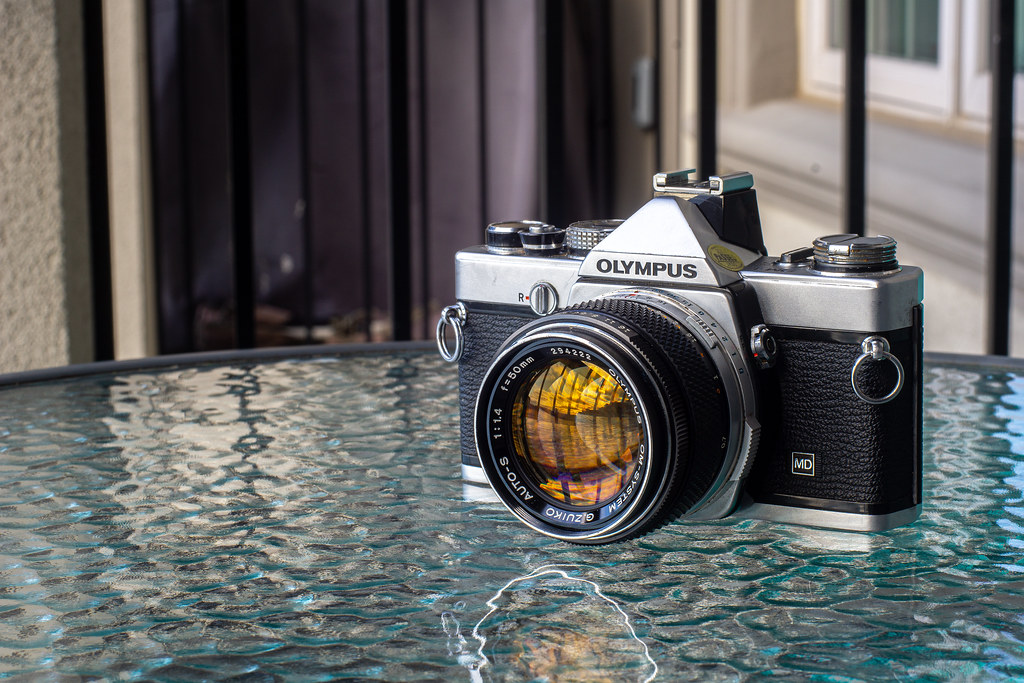I’m going to come out and say it right off the bat. I’m used to handling big and bulky SLRs. Yet as I feel smaller cameras like the Nikon FE, Nikon FA, and Pentax ME Super, I realised that there needed to be a single instigator of this shift in SLR size. That camera is the Olympus OM-1, released just under two decades from the first ‘system’ SLR, the Nikon F. But the OM-1 switched the game, changed the narrative on the system camera. It showed you didn’t need a bulky camera to get results. And those who use the OM-1 or any of the OM-System stand by these fantastic cameras. Not to mention the OM-System showed to the world that Olympus could adapt and change with technological shifts. And while I have had two OM-1 cameras in and out, I think back and go that an OM-System would be a worthy addition to any camera collection.

Camera Specifications
Make: Olympus
Model: M-1, OM-1, OM-1 MD, OM-1n
Type: Single Lens Reflex
Format: 135 (35mm), 36x24mm
Lens: Interchangeable, OM-Mount
Year of Manufacture: M-1 (1972), OM-1 (1973), OM-1 MD (1974), OM-1n (1979-1987)


Background
Olympus already had an established name within the camera industry in Japan but had not ventured into the SLR market. Sure there was the false start, a stopgap in the form of the Olympus FTL (some say Olympus didn’t even build it, but that’s a different story). Now they did produce an SLR, the non-traditional, half-frame Olympus Pen F, not to mention their amazing lens design in the D.Zuiko. Taking their three decades of design knowledge and leveraging the team of designers lead by Yoshihisa Maitani, they began to design not just an SLR, but a whole system. From the lenses, the body, focusing screens, drives, 250-shot backs, and more. Olympus would present to the world at the 1972 Photokina event, the Olympus M-1 and the M-System. Leica, of course, not happy and quickly went after Olympus who after 52,000 bodies rebadged everything to OM-System a year into production. The OM-1 was no different from any other SLR of the era, open-aperture metering with a CdS meter and an all-mechanical camera. By 1974 Olympus released an MD version to allow access to the new motor drive and 250-shot back and even older OM-1 units were offered upgraded bottom plates to allow for the use of the drive. By 1975 Olympus leveraged the new use of electronics to produce the semi-automatic OM-2. Both the OM-1 and OM-2 got updates in 1979 known as the OM-1n and OM-2n. The updates to the OM-1n included a redesign of the film advance, an updated flash interface to use the T-Series flash, and a flash ready indicator. The OM-1n proved so popular that even when Olympus released the OM-3 a mechanical version of the OM-4, the sale of the OM-1n continued well past even the discontinuation of the OM-2(n), OM-3, and OM-4. Production of the OM-1n would come to a close in 1987.


Impressions
If you’re used to traditional SLRs, the OM-1 might take a bit to get used to, I know I struggled at first. First thing you will notice is how small the camera body is, but don’t let that fool you either. The Olympus OM-1 shows that traditional minimalist sleek design that Maitani put into the PEN. Everything is in a perfect spot. The film advance is smooth and operates, now where you’d expect the shutter speed dial is the EI selector for your film. Your shutter speed is actually around the lens mount, right where you’d expect it to be, making it super easy not to move your hand away from your lens. Shutter speed, focus, aperture, and you never miss a shot. Thankfully there is a lock on the EI dial, so you don’t accidentally adjust the EI, thinking it’s the shutter speed. While the viewfinder is bright, it offers little in the way of feedback to your exposure settings, but it does use a match needle system for setting your exposure. The camera’s on/off switch is easily located on the top switch and greatly increases the camera’s battery life. And finally, the rewind switch is located on the front of the camera. While you might have some initial confusion, the ease of use of the camera will come with plenty of time and practice.


Experiences
I do have to say, the OM-1 is a joy to operate, once you get the hang of the steps away from traditional SLR design. Even with a motor drive, the camera is both small and light, easy to carry with plenty of lenses without having extra weight around your neck or in your camera bag. Even a small strap allows comfortable carrying for extended periods. Loading the film is quick and easy, and no different from any other SLR of the day. Despite having no feedback in the viewfinder, it’s a simple matter of dropping the camera down a bit, and you have both your aperture and shutter indicators right at the top of the lens. The shutter has a satisfying sound, and the film advance feels good in the hand and doesn’t have too long a stroke. Changing out lenses is just as fast as the traditional bayonet mount uses an on the lens release button and you can easily dismount and mount with one hand. Just remember that the rewind release is on the front of the camera, not the bottom.


Optics
If there’s one thing that Olympus got right, right off the mark is the optics. The Zuiko lenses available for the OM-System are the same quality optics that you saw on the PEN series, the Trip 35, and more Olympus cameras. And I’m not just talking about the prime lenses. The zoom lenses are top quality also. Now I am limited in this review working only with a prime 50mm f/1.8 lens, but honestly, you don’t need to get anything beyond an f/1.8 50mm. And if you can’t get your hands on the primes you want, don’t shy away from the zoom lenses. A good kit to start with is the 28 f/3.5, 50 f/1.8, and a short tele-zoom, something like a 75-150 or similar. That said if you want to expand your system, you can’t go wrong with upgrading your 28mm to an f/2.8 version, adding in the 100mm or 135mm short-telephoto, and even adding in a 35mm lens. While most won’t break the bank, the faster lenses will still fetch a high price on the used market. But if you’re patient, you’ll be able to get some good deals.


Lowdown
If you are looking for a camera system without compromise and don’t want to spend a pile of money on Canon or Nikon, then take a serious look at the OM-System. The OM-1(n) is a camera that will give you everything you want, and won’t break the bank. The bodies will cost between 100-150$ on the used market, and you can probably find one that comes with a lens for about that same price. As a mechanical camera, the battery only runs the light meter, and as I mentioned earlier, there’s a dedicated on/off switch. But you don’t have to worry about having a battery or even a working light meter if you want to meter through other methods. I find the OM-1 a camera designed for students, it’s small, light, compact, and awesome. Not to mention if you want to upgrade your body to something a little more modern like the OM-4Ti or OM-3Ti you can carry all your lenses with you. It certainly is a good system.


Further Reading
Don’t just take my word on the Olympus OM-1, you can check out the reviews by other awesome camera reviewers!
Camera Go Camera – Olympus OM-1 Review
Casual Photophile – Olympus OM-1 Review
Kosmo Foto – Around the World in 80 Cameras: Geneva on an Olympus OM-1
Down the Road – Olympus OM-1 Review
Emulsive – Olympus OM-1n Review
The Gas Haus – Olympus OM-1n
Film Photography Project – The Compact, Awesome Olympus OM-1
4 Comments